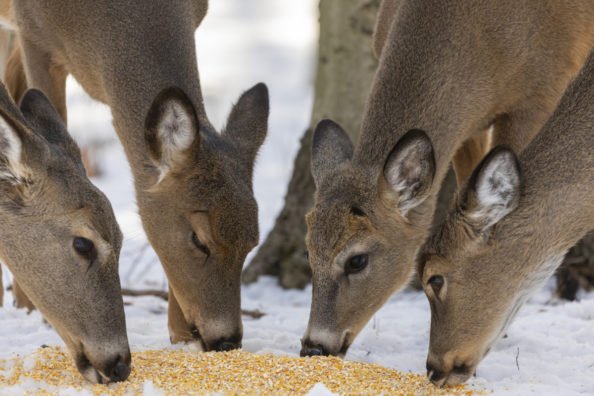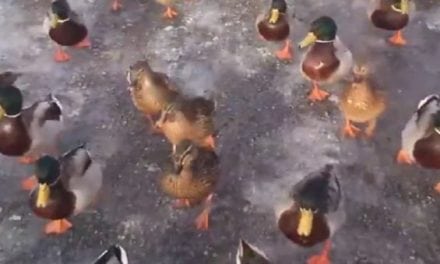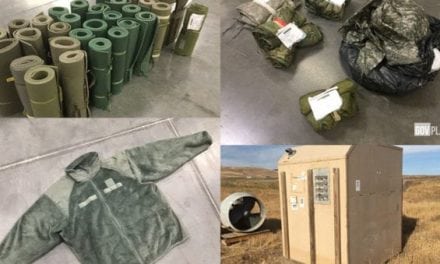
Deer baiting is still one of the hot-button issues in hunting.
One of the more unfortunate things about deer hunting is the way that some hunters have ended up divided on the legalities and ethics of certain tactics and practices. Almost every hunter has an opinion on things like hunting deer with dogs, deer drives, or high fence hunting.
One of the bigger hot topics of debate is the use of bait piles to draw in deer close enough for a shot. Many states have taken to banning the practice entirely. There are many elements to this debate. Questions of fair chase, the healthiness of supplemental feeding of deer, and the ever-looming shadow of deer disease are prevalent in it.
So, let’s look at deer baiting a little closer and try to weigh the arguments on both sides of the great bait debate. My hope is no matter what side of the fence you fall on, you will at least have a better understanding of the other side’s argument.
Where, how and why baiting is popular.
From my own experience, it seems like the practice of deer baiting is mostly a midwestern thing for whitetails. Hunters in places like Michigan, Minnesota, Indiana, Kentucky, Wisconsin, and Missouri have all had some form of deer baiting at one point or another. We will get into later why many of these states do not anymore. In any case, most baiting involves just dumping a pile of corn, grain, hay, apples, carrots, or beets on the ground in a prime location to attract deer. Most states lump things like mineral and salt licks into their definition of bait for simplicity.
Some states have very specific rules about where and when you can use bait. For example, South Carolina has a baiting ban in place on their public lands only. Private land hunters can still use bait during deer hunting season. Other sites have similar baiting regulations in place.
The reason baiting is popular is simply because it works. In areas where the wild deer are hard to find, hunters can artificially alter the travel routes of deer to take them past bait sites. Putting them within easy range of a strategically placed treestand or ground blind. Many bow hunters have gotten their first kill off a pile of bait.
In defense of deer baiting.
Let us look at the pros of deer baiting to start. As we have already mentioned, putting out bait is going to give you slightly better odds of a harvest because it can attract and form new habits in a deer herd that might otherwise just be scattered everywhere. A good example of this is the big woods areas of Michigan’s Upper Peninsula, where baiting is still legal despite a total ban being enacted in the Lower Peninsula.
Michigan’s U.P. does not have nearly as much agriculture as the southern part of the state. There are thousands of acres of public state forest. Combine that with a much lower deer density than other parts of the state and many deer hunters feel like they are looking for a needle in a haystack. For some hunters, bait may be their only chance at putting venison in the freezer. They may only see one deer a year, and when they get the opportunity, they take it.
Another benefit is to the local economy. I’ve written about baiting before and had more than one small business owner in northern Michigan email me afterwards to tell me their business suffered great losses after the Department of Natural Resources, (DNR) decided to institute a baiting ban across the entire lower peninsula. It is common for “mom and pop” gas stations to sell bags of corn and beets to the hunters on their way north from the southern part of the state. Once that income was not there anymore, many were now feeling the effects on their pocketbook.
Baiting is also an effective tool for helping youth hunters or hunters with disabilities harvest an animal. If you have someone in a wheelchair, getting them in front of a deer can be a tall order without a little help from a bait pile to put the animal in perfect position for a shot. Bait is an especially effective tool for helping blind hunters get a shot because the animal is not moving, and it allows whoever is assisting them to help them get on target faster. Michigan does make an exception to their baiting ban for disabled hunters.
For the younger hunters with shorter attention spans, it also helps keep their interest. Deer will usually filter into bait quickly, meaning there is more for them to see while waiting for that big buck. You do not want them to get bored and lose interest in hunting. We have enough problems with hunter retention as it is already.
In defense of baiting bans.
The flip side of the coin is all the health problems that herds can face with baiting. The reason the Michigan DNR decided to enact a ban was due to things like chronic wasting disease and bovine tuberculosis. When deer congregate near a bait pile, they are in close contact with one another. Most scientists believe diseases like CWD can then spread through saliva and the deer being nose-to-nose on these piles.
When one of these diseases gets into the deer population, it can be tough to exterminate. Some animals may not show symptoms of the disease for years. However, at the same time, they may be spreading the prions that cause the disease to other deer. It gets problematic when you consider how far some bucks like to wander looking for does during the rut. In the case of Michigan, they have extremely strict regulations of how much bait can be used in the few areas it is legal. They require bait cannot exceed two gallons and that whatever is used must be scattered over a 10-foot area at a minimum. Other states have similar baiting regulations and the whole point is to avoid keeping the deer on the piles in close contact for hours on end. Is the health of the herd worth risking for the ability to see and harvest animals more easily?
We could talk about the disease aspect for of trying to bait deer for hours, but most of it has been covered before. Let us talk about the ethics of it. Is using bait fair chase? This seems to be a regional thing, at least in my experience. Hunters in many Midwestern states often balk at the idea of statewide bait ban imposed by the gov. I have often seen hunters who do not use bait attacking the ones that do, telling them to “learn how to hunt properly.” It always struck me as a little harsh. Especially when you are talking about archery hunting. If the hunter makes a clean kill and it is legal, do the methods matter?
Mostly because the same hunters who discourage bait will often spend hours on end in the summer months building and maintaining food plots to attract the deer. Is there a real difference? The only major difference being that food plots are legal because they do not concentrate the deer in one tiny area.
The real question then becomes, if bait is unethical, why are food plots any different? After all, both are human-provided food sources that are going to alter the behavior of the deer in the areas they are placed. It is hard to say. Getting the deer to stop exactly where you need it for a clean shot with a crossbow or compound bow does seem like it may be more unfair than trying to coax a buck to a specific spot in a food plot. There may not be a clear answer to this part of the debate.
Should we stop using bait for deer?
This is a question that is hard to answer. Personally, I have harvested deer both without and with bait back when it was legal. None of my largest bucks were taken over bait. Personally, I think most big boys are far too wary to come into one of those piles in the daylight hours. Because of that, I am not sure it offers as big of an advantage as some people may believe. This will probably vary from state to state though.
I see arguments for both sides and no easy answers for either. The health of the deer herd is an important argument against it, but the success of disabled and younger hunters is a good argument for it. If baiting is legal in your area, it is going to be up to each individual hunter to decide what is and is not ethical for themselves.
These are the issues that wildlife officials must struggle with when it comes to deer management. I am just glad I am not one of the officials that must make the decisions that affect the hundreds of thousands of hunters, businesses, and the deer herd of my state. It cannot be easy to make any of them.
Some self-reflection by all hunters may be a good idea on hot topics like baiting. Because we simply do not have enough hunters on our side to start dividing amongst ourselves further. In the end, perhaps it may be best to just respect one another, and our hunting methods so long as they are legal.
One thing is for sure, unless wildlife biologists can eradicate major deer diseases like CWD completely, the arguments over the use of bait for deer and other game is likely to continue.
Products featured on Wide Open Spaces are independently selected by our editors. However, when you buy something through our links, we may earn a commission.
For more outdoor content from Travis Smola, be sure to follow him on Twitter and check out his Geocaching and Outdoors with Travis YouTube channels.
NEXT: THE AXIS DEER AND HOW THEY’RE IMPACTING PARTS OF THE UNITED STATES
WATCH
The post Deer Baiting Ethics: Weighing the Pros and Cons appeared first on Wide Open Spaces.
















